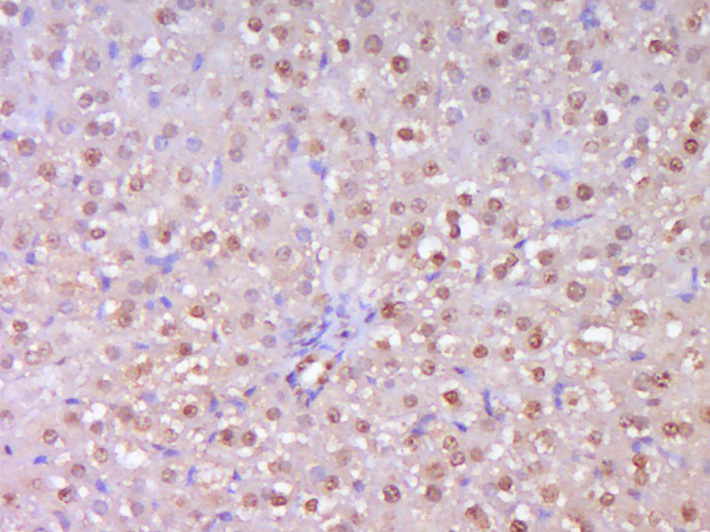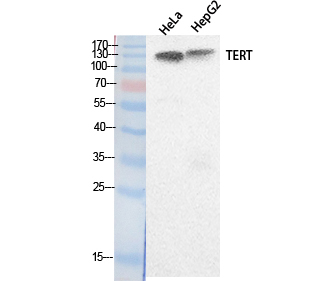![WB analysis of MJ90 cell lysate using GTX30410 TERT antibody [2C4]. Dilution : 1:500 WB analysis of MJ90 cell lysate using GTX30410 TERT antibody [2C4]. Dilution : 1:500](https://www.genetex.com/upload/website/prouct_img/normal/GTX30410/GTX30410_1397_WB_w_23060722_737.webp)
WB analysis of MJ90 cell lysate using GTX30410 TERT antibody [2C4]. Dilution : 1:500
TERT antibody [2C4]
GTX30410
ApplicationsFlow Cytometry, ImmunoFluorescence, ImmunoPrecipitation, Western Blot, ChIP Chromatin ImmunoPrecipitation, ImmunoCytoChemistry, ImmunoHistoChemistry, ImmunoHistoChemistry Paraffin
Product group Antibodies
ReactivityHuman, Mouse, Rat
TargetTERT
Overview
- SupplierGeneTex
- Product NameTERT antibody [2C4]
- Delivery Days Customer9
- Application Supplier NoteWB: 1:500. ICC/IF: 1:50-1:200. IHC-P: 1:50. FACS: 1:50-1:200. IP: 1:10 - 1:500. *Optimal dilutions/concentrations should be determined by the researcher.Not tested in other applications.
- ApplicationsFlow Cytometry, ImmunoFluorescence, ImmunoPrecipitation, Western Blot, ChIP Chromatin ImmunoPrecipitation, ImmunoCytoChemistry, ImmunoHistoChemistry, ImmunoHistoChemistry Paraffin
- CertificationResearch Use Only
- ClonalityMonoclonal
- Clone ID2C4
- Concentration1 mg/ml
- ConjugateUnconjugated
- Gene ID7015
- Target nameTERT
- Target descriptiontelomerase reverse transcriptase
- Target synonymsCMM9, DKCA2, DKCB4, EST2, PFBMFT1, TCS1, TP2, TRT, hEST2, hTRT, telomerase reverse transcriptase, telomerase catalytic subunit, telomerase-associated protein 2
- HostMouse
- IsotypeIgM
- Protein IDO14746
- Protein NameTelomerase reverse transcriptase
- Scientific DescriptionTelomerase is a ribonucleoprotein polymerase that maintains telomere ends by addition of the telomere repeat TTAGGG. The enzyme consists of a protein component with reverse transcriptase activity, encoded by this gene, and an RNA component which serves as a template for the telomere repeat. Telomerase expression plays a role in cellular senescence, as it is normally repressed in postnatal somatic cells resulting in progressive shortening of telomeres. Deregulation of telomerase expression in somatic cells may be involved in oncogenesis. Studies in mouse suggest that telomerase also participates in chromosomal repair, since de novo synthesis of telomere repeats may occur at double-stranded breaks. Alternatively spliced variants encoding different isoforms of telomerase reverse transcriptase have been identified; the full-length sequence of some variants has not been determined. Alternative splicing at this locus is thought to be one mechanism of regulation of telomerase activity. [provided by RefSeq]
- ReactivityHuman, Mouse, Rat
- Storage Instruction-20°C or -80°C,2°C to 8°C
- UNSPSC12352203
References
- Mushtaq I, Bhat GR, Rah B, et al. Telomere Attrition With Concomitant hTERT Overexpression Involved in the Progression of Gastric Cancer May Have Prognostic and Clinical Implications in High-Risk Population Group From North India. Front Oncol. 2022,12:919351. doi: 10.3389/fonc.2022.919351Read this paper
- Min S, Kwon SM, Hong J, et al. Mitoribosomal Deregulation Drives Senescence via TPP1-Mediated Telomere Deprotection. Cells. 2022,11(13). doi: 10.3390/cells11132079Read this paper
- Haraguchi K, Habu M, Yada N, et al. Human telomerase reverse transcriptase protein expression is associated with survival in patients with oral squamous cell carcinoma. Int J Clin Exp Pathol. 2022,15(1):29-37.Read this paper
- Shin WH, Chung KC. Human telomerase reverse transcriptase positively regulates mitophagy by inhibiting the processing and cytoplasmic release of mitochondrial PINK1. Cell Death Dis. 2020,11(6):425. doi: 10.1038/s41419-020-2641-7Read this paper
- Shen Y, Xi F, Li H, et al. Telomerase reverse transcriptase suppression inhibits cell proliferation and promotes cell apoptosis in hepatocellular cancer. IUBMB Life. 2018,70(7):642-648. doi: 10.1002/iub.1758Read this paper
- Haraguchi K, Yada N, Sato S, et al. The methylation status and expression of human telomerase reverse transcriptase is significantly high in oral carcinogenesis. APMIS. 2017,125(9):797-807. doi: 10.1111/apm.12723Read this paper
- Aras G, Kanmaz D, Urer N, et al. Immunohistochemical expression of telomerase in patients with non-small cell lung cancer: prediction of metastasis and prognostic significance. Anticancer Res. 2013,33(6):2643-50.Read this paper
- Schauer IG, Zhang J, Xing Z, et al. Interleukin-1β promotes ovarian tumorigenesis through a p53/NF-κB-mediated inflammatory response in stromal fibroblasts. Neoplasia. 2013,15(4):409-20.Read this paper
- Liu S, Qi Y, Ge Y, et al. Telomerase as an important target of androgen signaling blockade for prostate cancer treatment. Mol Cancer Ther. 2010,9(7):2016-25. doi: 10.1158/1535-7163.MCT-09-0924Read this paper

![IHC-P analysis of human pancreas carcinoma tissue using GTX30410 TERT antibody [2C4]. IHC-P analysis of human pancreas carcinoma tissue using GTX30410 TERT antibody [2C4].](https://www.genetex.com/upload/website/prouct_img/normal/GTX30410/GTX30410_323_IHC-P_w_23060722_306.webp)
![IHC-P analysis of human pancreas tissue using GTX30410 TERT antibody [2C4]. IHC-P analysis of human pancreas tissue using GTX30410 TERT antibody [2C4].](https://www.genetex.com/upload/website/prouct_img/normal/GTX30410/GTX30410_324_IHC-P_w_23060722_718.webp)




![WB analysis of MJ90 cell lysate using GTX25405 TERT antibody [2D8].](https://www.genetex.com/upload/website/prouct_img/normal/GTX25405/GTX25405_1297_WB_w_23060722_870.webp)
